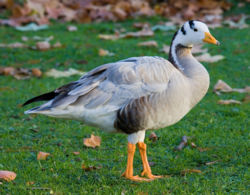 The superlative for the highest altitude migrant goes to the Bar-headed Goose (Anser indicus), which has been seen at up to 33,382 feet (10175 m). This bird, which breeds in Central Asia, migrates through the Himalayan range. The air at these heights is so thin that helicopters cannot fly there and kerosene cannot burn. The Bar-head has a slightly larger wing area for its weight than other geese, which is believed to help the goose fly so high.
The superlative for the highest altitude migrant goes to the Bar-headed Goose (Anser indicus), which has been seen at up to 33,382 feet (10175 m). This bird, which breeds in Central Asia, migrates through the Himalayan range. The air at these heights is so thin that helicopters cannot fly there and kerosene cannot burn. The Bar-head has a slightly larger wing area for its weight than other geese, which is believed to help the goose fly so high.
Audubon Magazine continues:
The yearly migration of these geese is apparently triggered by a biological alarm that rings early enough in the spring for them to miss the summer monsoon season and early enough in the fall for them to miss the worst of winter’s storms. Still, they cast their fates to the wind only with due consideration. Geese poised to take off, for example, may delay their flight if strong headwinds kick up. And when airborne birds get tossed about, they may turn back and land or change altitude in search of better conditions.
Moreover, by using tailwinds, the geese capitalize on weather that could pulverize lesser creatures. “These birds are powerful flappers, not soarers that just glide with the wind,” says M.R. Fedde, an emeritus professor of anatomy and physiology at Kansas State University’s School of Veterinary Medicine, who has conducted laboratory studies of the bar-headed goose’s respiratory system. Partly because their wings are huge, have a disproportionately large surface area for their weight, and are pointed to reduce wind resistance, “they can fly over 50 miles an hour on their own power,” Fedde says. “Add the thrust of tailwinds of perhaps 100 miles an hour if they are lucky, and these birds really move.” Able to gauge and correct for drift, bar-headed geese can even fly in crosswinds without being blown off course. The same powerful and unremitting flapping that helps propel them over the mountains also generates body heat, which is retained by their down feathers. This heat, in turn, helps keep ice from building up on their wings.
What’s the secret to the bar-headed goose’s aerobic success? “First of all, bar-headed geese are birds,” says S. Marsh Tenney, an emeritus professor of physiology at Dartmouth Medical School, whose research on respiratory adaptations to oxygen deprivation includes studies of these highfliers. “And all birds are built for particularly efficient oxygen uptake.” The avian breathing system is uniquely structured. Among its special features are several sacs that temporarily store inhaled air that has passed through the lungs and then send it back through their lungs before it is exhaled. Thus, birds circulate inhaled air through their lungs twice–once more than earthbound mammals do–increasing their opportunities for capturing oxygen.
Additional information can be found via the IUCN Red List of Threatened Species.


Hallo…
I’m an Italian teacher, active in skeptical organizations :)
Since you dealt with the topic some weeks ago, could you help me understanding if the great performance of Brownback supporters about the *Helioleftist moral panic*, is a parody or not?
I wrote something here:
http://paniscus.splinder.com/1184961679#13159511
bye
Lisa
By: paniscus on July 20, 2007
at 4:18 pm
Who is the flight picture by?
I would like to ask permission to use it in presentations about Bar headed geese.
By: Lucy Hawkes on September 23, 2008
at 4:53 pm
Shoot, I don’t remember where I got that, although I recall it being a cropped version of a larger image.
By: Dan on September 23, 2008
at 7:12 pm
We currently have a lone Bar-headed goose in SE Vermont. I appreciate the info about these fascinating birds.
By: Paul Miller on April 25, 2009
at 2:05 am
We have a bar headed goose settled on the 5th hole at the Brattleboro Country Club in SE Vermont. It has joined a group of geese and I’m, wondering where it might have come from. We first noticed it yesterday, May29th and again today.
By: Stephanie Case on May 31, 2009
at 5:26 am
bar headed goose should be saved and i appreciate those people who are trying to save this bird
By: zubida on December 17, 2009
at 9:28 am
These birds have gained the attention of man for a very long time. There is even a whole taoist qigong system based on the movements and character of the Bar Headed goose known as Kunlan Dayan Qigong.
It is 1800 years old and consists of 72 separate forms. This is truly a remarkable bird. I would love to be able to use one of these pictures for a website. Are they copyrigh?
By: David on May 6, 2010
at 12:51 pm
David,
These pictures are from the Wikipedia entry (click on the first pic above). They’re free to use, as long as it is for non-commercial use.
By: Dan on May 6, 2010
at 1:26 pm